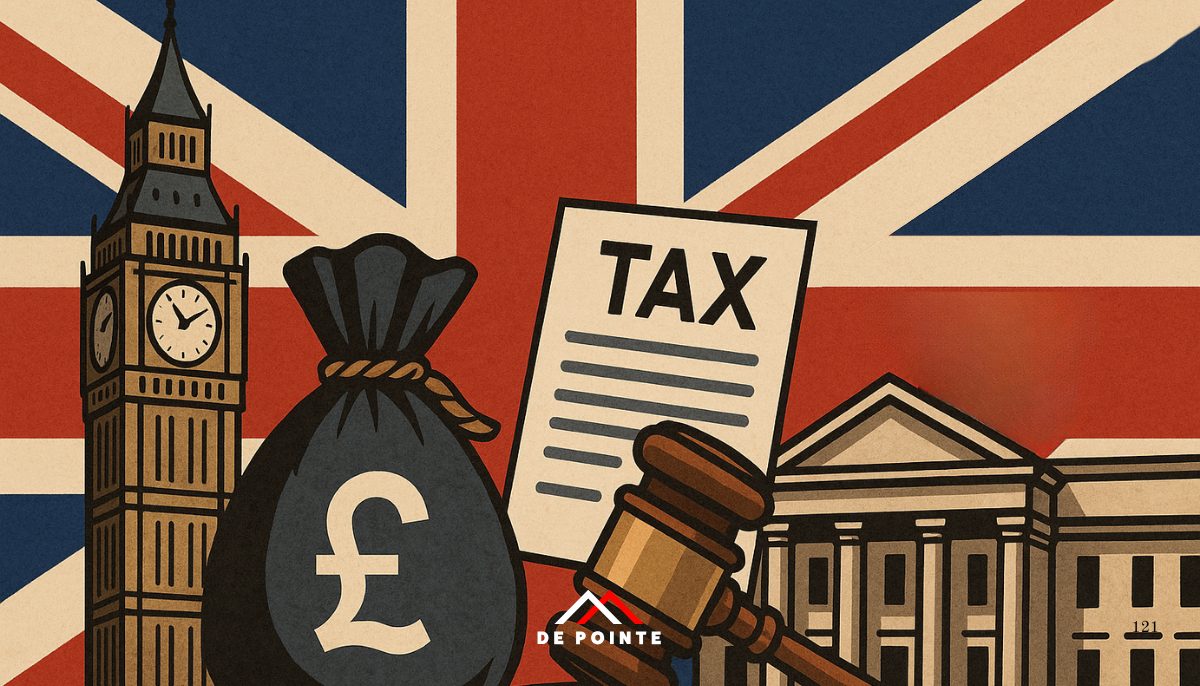Article

The UK Labour tax changes in 2025 are reshaping the landscape for investors, business owners, and high-net-worth individuals. With reforms already implemented and others scheduled for 2026–27, investors must understand the implications for capital gains, inheritance tax, pensions, and alternative assets.
In this guide, De Pointe Research explores the confirmed measures, upcoming reforms, and how investors can position their portfolios strategically.
UK Labour’s “tax lock” pledge
Labour has committed not to raise the rates of Income Tax, employee National Insurance, or VAT for “working people,” and has capped corporation tax at 25%. However, this pledge does not cover allowances, employer NICs, or wealth-related taxes, where significant changes are already underway.
Key Labour tax changes already in force
Capital Gains Tax rise (October 2024)
- Basic rate: 18%
- Higher/additional rate: 24%
- Business Asset Disposal Relief (BADR) and Investors’ Relief: stepping up to 14% (2025) and 18% (2026).
- Carried interest: 32% from 2025, with income-style taxation in 2026.
Employer National Insurance increase (April 2025)
- The rate rose from 13.8% to 15%.
- Secondary threshold lowered to £5,000.
- Employment Allowance increased to £10,500 for smaller firms.
Non-dom regime abolished (April 2025)
- Replaced with a residence-based Foreign Income and Gains (FIG) system.
- Four-year relief for new arrivals.
- Inheritance tax is now shifting toward a residency basis.
VAT on private school fees (January 2025)
- Standard-rate VAT applies to private school tuition and boarding.
- Anti-forestalling rules backdated to October 2024.
Windfall tax on North Sea oil & gas
- Energy Profits Levy extended to March 2030.
- 29% investment allowance removed, leaving only a decarbonisation allowance.
Labour tax reforms scheduled for 2026–27
Inheritance Tax on pensions (April 2027)
Most unused pension funds and death benefits will fall within taxable estates for IHT.
Agricultural & Business Property Relief cap (April 2026)
APR and BPR will be capped at £1m combined.
Labour tax reforms under review
- Property taxation overhaul: Reform of stamp duty and council tax based on outdated 1991 valuations.
- Inheritance Tax tightening: Possible restrictions on lifetime gifting and taper relief adjustments.
What UK Labour tax changes mean for investors
1. Asset location is critical
With higher CGT rates, investors should maximise ISAs and pensions, and carefully plan disposals across tax years.
2. Pensions no longer simple estate tools
From 2027, pensions face inheritance tax exposure, prompting a review of drawdown, gifting strategies, and estate planning.
3. Alternative assets retain advantages
- Gold: Investment-grade bullion remains VAT-exempt, with UK legal-tender coins (e.g., Britannias, Sovereigns) CGT-free.
- Art: Still subject to CGT, making tax-efficient structures and timing important.
- Private equity: Carried interest reforms may reshape fee structures.
4. Business owners hit by higher employer NICs
Budgeting for the 15% employer NIC rate and reduced thresholds is essential.
5. Property investors face uncertainty
Pending stamp duty and council tax reform could reshape investment timing and regional appeal.
Quick reference: Labour tax changes timeline
| Area | Status | Key date |
| Capital Gains Tax rise | In force | Oct 2024 |
| Employer NIC to 15% | In force | Apr 2025 |
| Non-dom regime abolished | In force | Apr 2025 |
| VAT on private school fees | In force | Jan 2025 |
| North Sea windfall tax | Extended | To 2030 |
| APR/BPR IHT cap | Announced | Apr 2026 |
| Pensions within IHT scope | Legislated | Apr 2027 |
| Property tax reform | Under review | TBC |
De Pointe Research: Our view
The Labour government’s tax lock may shield workers from higher Income Tax, but wealth and capital are firmly in scope. Investors face rising CGT, shrinking reliefs, and the most significant inheritance tax reform in decades.
For investors in gold, art, and private markets, tax efficiency now plays a bigger role in portfolio strategy.
Next steps for investors
- Review portfolio wrappers (ISAs, pensions, trusts) before CGT or IHT changes bite.
- Revisit estate planning – pensions will no longer sit outside IHT from 2027.
- Consider alternative assets like CGT-free Royal Mint gold coins for tax efficiency.
- Stay alert to property tax reform in the Autumn Budget.
At De Pointe Research, we specialise in helping investors protect and grow their wealth in times of fiscal and market change.
Contact us today to discuss how to position your portfolio under Labour’s evolving tax framework.






